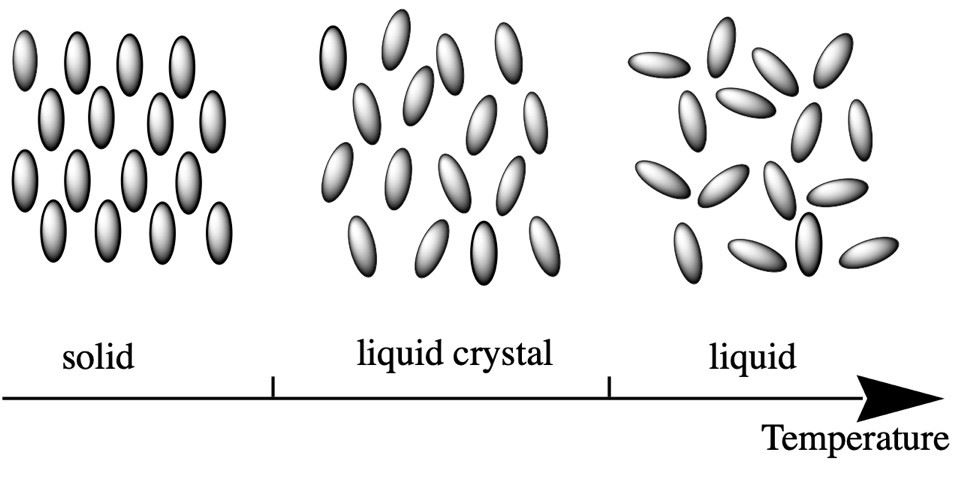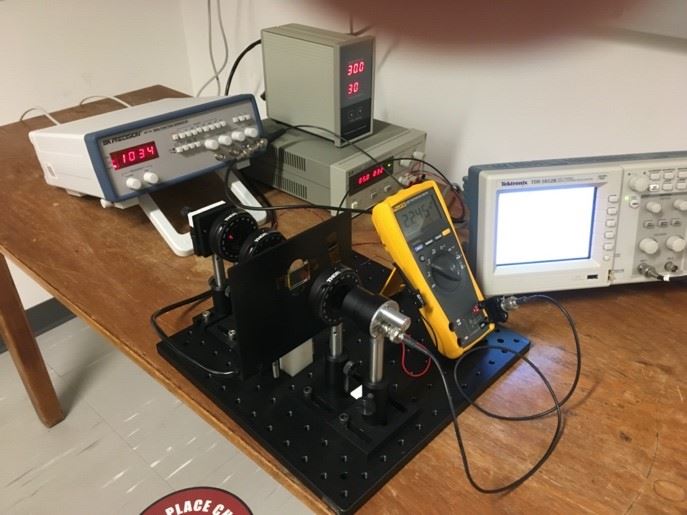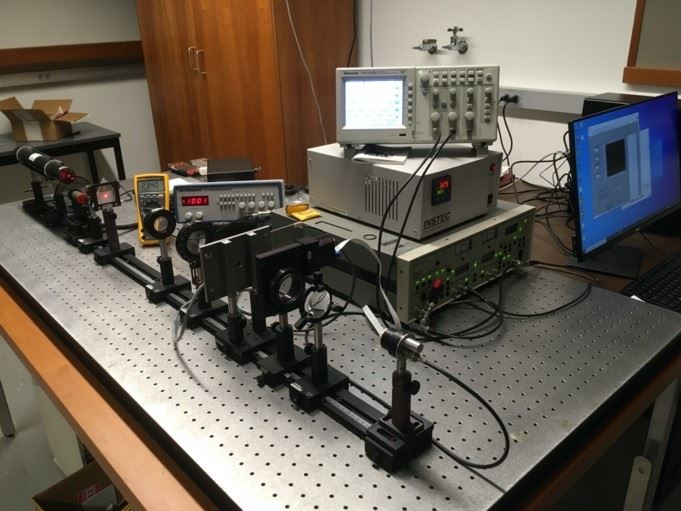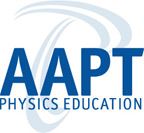- Home
- What We Do
- Laboratory Immersions
- Immersions 2022
- Imm2022Swarthmore_LiquidCrystals
Swarthmore College, Swarthmore PA
The Physics of Liquid Crystals: Thermodynamics, Optics, Electromagnetism
Dates: June 14, 2022 to June 16, 2022
Number of setups
available: 4
Maximum
number of participants: 8
------------------------------------------------------------------------------------------------------------------------------------------
In addition to the solid, liquid, and gas phases, some substances possess a fourth phase of matter called the liquid crystal phase. As shown in the figure below, in this phase the molecules possess a small amount of orientational order as they undergo liquid-like diffusion. Phase transitions separate the liquid crystal phase from other phases; in fact, the liquid crystal to liquid transition reveals the basic thermodynamics common to all phase transitions. The presence of orientational order means that liquid crystals interact with light in many of the ways solids do. This means that the behavior of polarized light can be explored by investigating the optics of the liquid crystal phase. Finally, because liquid crystals are fluids, they have a robust response to weak external fields, a fact that makes the ubiquitous liquid crystal display (LCD) possible. Only a basic knowledge of electric fields is necessary to understand the behavior of an LCD.

A commercial compound that is a liquid crystal at room temperature is used in the experiment. This means the sample is a fluid at room temperature and can be introduced into a commercial thin cell simply by capillary action. In addition, the compound resembles an oil and is very safe.
The basic apparatus consists of a low-power diode or gas laser, two rotatable linear polarizers, a photodetector, a temperature-controlled stage to hold the liquid crystal cell, and a function generator to supply voltage to the liquid crystal cell. The optical components are mounted on an optical rail or optical base. The basic apparatus can be improved to research grade quality by upgrading the laser, using a high precision temperature-controlled stage, adding a chopper and lock-in amplifier, or by utilizing a stepper motor-controlled rotation stage connected to a computer.
The apparatus is used to measure the optical retardation of the liquid crystal, either by measuring the photodetector voltage for two positions of a polarizer or by recording the photodetector voltage as a polarizer is rotated through 180°. Some background in the physics of polarized light is required, so it is an excellent opportunity for students to learn the very basics of Jones calculus, a fundamental tool when using polarized light. The optical retardation measurement is performed at various temperatures, concentrating on the region close to the phase transition to a liquid, which is less than 20°C above room temperature for the liquid crystal compound used. The difference between the two indices of refraction of the liquid crystal, called its birefringence, is calculated from the optical retardation. Since the birefringence is proportional to the order parameter of the liquid crystal, the temperature dependence of the order parameter can be fit to a theory for the transition that is very similar to the Landau theory of magnetic phase transitions.


Less Expensive Apparatus Research Quality Apparatus
The optical retardation can also be measured as a voltage is applied to the liquid crystal cell. The response of the cell is quite interesting because it shows a threshold effect. Up to a threshold value of the applied voltage, the liquid crystal does not respond at all; for voltages above the threshold value, increasing the voltage increases the deformation in the liquid crystal orientation induced by the electric field. This behavior of the liquid crystal can be understood with the basic concepts of electric fields in matter plus an energy minimization procedure reminiscent of Lagrangian classical mechanics. Application of a low frequency square wave also shows the temporal response of the liquid crystal when the voltage is switched, revealing that the turn-on and turn-off times are quite different.
Understanding the liquid crystal phase and the basic mechanism of LCDs is a wonderful introduction to an increasingly important technology. Liquid crystals are an example of soft matter, a rapidly growing area of research and technology that includes polymers, emulsions, colloidal suspensions, and elastomers. The softness of these materials allows for applications in flexible displays, numerous optical devices, artificial muscles, biological scaffolds, and programmable materials.
Students learn many aspects of performing optics experiments, including proper alignment, adjustment of sources and detectors, and manipulating optical components. In addition, expertise in modern temperature control techniques and the application of alternating electric fields is gained. The apparatus allows the students and instructor to make choices about the nature of the experiment, whether it is to acquire precise data near a phase transition, study the response of a liquid crystal to an electric field, and/or investigate the switching behavior of a basic LCD. In all of these cases, there are theoretical concepts that the students can understand and bring to bear on the experimental data they have acquired, thus emphasizing the interplay between theory and experiment.
The 2.5 day immersion will be organized as follows: (1) a half-day going over the background theory and operation of the components of the experiment, including filling a commercial cell with a liquid crystal, which is then used throughout the immersion; (2) three half-day rotations of pairs of participants through the different experimental set-ups, each differing in the sophistication (and therefore cost) of the set-up, and (3) a final half-day to complete unfinished data acquisition or data analysis and discuss aspects of setting up a similar experiment on each home campus. Participants will leave with fully analyzed data from multiple experimental set-ups, a commercial cell filled with a liquid crystal, an empty commercial cell, and a small amount of liquid crystal compound.
Participants will plot their experimental results, analyze data (including curve fitting), and perform calculations. Although computers will be available with all the necessary software, participants are encouraged to bring their own computer and software so their work at the immersion is compatible with the resources at their home institution.
The cost of setting up the experiment varies widely, depending on the choice of apparatus and the equipment already available at the home institution. A set-up consisting of a diode laser, power supply, a battery-operated photodetector, an inexpensive temperature-controlled stage, a function generator, a voltmeter, and the necessary optical components comes to about $5,000. This can be reduced to roughly $3,000 if a low power laser and standard electronic instrumentation are available (even less if optics components are on hand). A research quality set-up with a low-power gas laser, precise temperature stage, a computer-controlled polarizer, a lock-in amplifier, and additional optical components adds around $5,000 to the cost, not including the computer and interfacing software such a LabView.
 Mentors: Peter J. Collings
Mentors: Peter J. Collings
Peter Collings has taught at Swarthmore College for 27 years, and prior to that, taught at Kenyon College for 14 years. A soft matter experimentalist specializing in liquid crystals, he has written both an introductory book and a textbook on liquid crystals, both in their second editions, and published roughly 100 research articles. During his career, he designed many instructional laboratory experiments at all levels of the physics major curriculum, including advanced laboratory experiments measuring semiconductor bandgaps, noise characteristics using autocorrelation functions, and characteristics of liquid crystals and LCDs.
Morris L. Clothier Emeritus Professor of Physics, Swarthmore College pcollin1@swarthmore.edu
Please note that the Jonathan F. Reichert Foundation has established a grant program
to help purchase apparatus used in Laboratory Immersions. Limitations
and exclusions apply, but generally speaking the Foundation may support
up to 40% of the cost of the required equipment.





